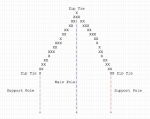albatros
Member
Hello everyone. I guess I should first introduce myself. If you'd like to skip the introduction, please continue from the second paragraph. I am a prepper and a CB enthusiast living in Ankara, Turkey. I have always wanted to host an amateur (pirate) radio station of my own but after I have turned 18, I have realized that it wouldn't be that good of an idea after all -with the legal limitations-. Therefore I carried on using my Motorola T4500 GMRS walkie talkies. However, all these didn't stop me and few days ago I did my first CB radio. I will be using it both mobile and at home, so I need some advice about that.
To start by, the CB radio I bought is President Jackson (Silver). I am using a magnetic car antenna with that device (which came with it). When I am in car, power socket is not a problem since there is the good old lighter plug and when I am home I am using a home brew 12VDC 16AMP computer power supply. However, the antenna became a little of a problem here. I live in a flat (5th floor) and don't have any balconies, etc. at all. Therefore I am attaching my car antenna to the metal mounting pipe of my satellite dish and connected the dish to the radiator in the room (for ground). I have made a small coil around the antenna and tested the transmission with a multimeter (on AC Volts). There is transmission (generating around .9 VAC). However, I am not sure if I am doing something wrong since I don't receive any reply on any frequencies (A,B,C,D and E bands, 1-40 channels and +10KHz 1-40 channels on FM, AM, USB, LSB). As far as I know, the output of the head unit is modified and increased to around 40 watts. Therefore I expect somebody to hear my transmission and reply, but nope. I started to think that I am doing something wrong (duh!). Therefore I need all kinds of advice I can get. And I also have some questions such as which transmission mode should be chosen for long range radio communications and which Band/Channel pairs I would be most likely to receive a transmission.
Sorry for the long post, I will be ending it with some photographs of the setup. Sincere thanks to everyone trying to help.
Images: https://drive.google.com/open?id=0B0n2wkH3pLNcdzF0a2xZdE9ZbUU
To start by, the CB radio I bought is President Jackson (Silver). I am using a magnetic car antenna with that device (which came with it). When I am in car, power socket is not a problem since there is the good old lighter plug and when I am home I am using a home brew 12VDC 16AMP computer power supply. However, the antenna became a little of a problem here. I live in a flat (5th floor) and don't have any balconies, etc. at all. Therefore I am attaching my car antenna to the metal mounting pipe of my satellite dish and connected the dish to the radiator in the room (for ground). I have made a small coil around the antenna and tested the transmission with a multimeter (on AC Volts). There is transmission (generating around .9 VAC). However, I am not sure if I am doing something wrong since I don't receive any reply on any frequencies (A,B,C,D and E bands, 1-40 channels and +10KHz 1-40 channels on FM, AM, USB, LSB). As far as I know, the output of the head unit is modified and increased to around 40 watts. Therefore I expect somebody to hear my transmission and reply, but nope. I started to think that I am doing something wrong (duh!). Therefore I need all kinds of advice I can get. And I also have some questions such as which transmission mode should be chosen for long range radio communications and which Band/Channel pairs I would be most likely to receive a transmission.
Sorry for the long post, I will be ending it with some photographs of the setup. Sincere thanks to everyone trying to help.
Images: https://drive.google.com/open?id=0B0n2wkH3pLNcdzF0a2xZdE9ZbUU



